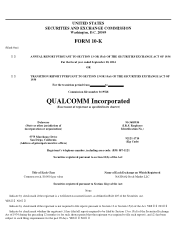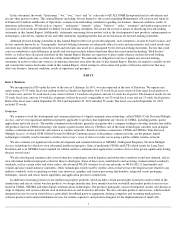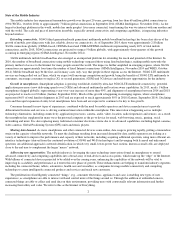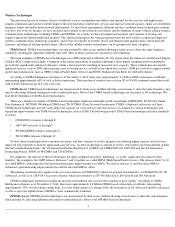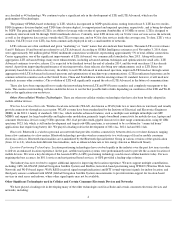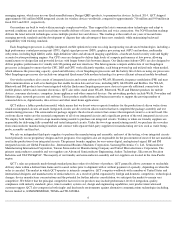Qualcomm 2014 Annual Report Download - page 7
Download and view the complete annual report
Please find page 7 of the 2014 Qualcomm annual report below. You can navigate through the pages in the report by either clicking on the pages listed below, or by using the keyword search tool below to find specific information within the annual report.
State of the Mobile Industry
The mobile industry has experienced tremendous growth over the past 20 years, growing from less than 60 million global connections in
1994 (WCIS+, October 2014) to approximately 7 billion global connections in September 2014 (GSMA Intelligence, November 2014). As the
largest technology platform in the world, mobile has made peoples’
lives more connected, transforming the way we interact with one another and
with the world. The scale and pace of innovation in mobile, especially around connectivity and computing capabilities, is impacting industries
beyond wireless.
Extending connectivity. 3G/4G (third generation/fourth generation) multimode mobile broadband technology has been a key driver of the
growth of mobile, providing users with fast, reliable, always-on connectivity. As of September 2014, there were approximately 2.8 billion
3G/4G connections globally (CDMA-based, OFDMA-based and CDMA/OFDMA multimode) representing nearly 40% of total mobile
connections, and by 2018, 3G/4G connections are projected to surpass 5 billion globally, with approximately three-quarters of this growth
occurring in emerging regions (GSMA Intelligence, November 2014).
3G/4G multimode mobile broadband has also emerged as an important platform for extending the reach and potential of the Internet. In
2010, the number of broadband connections using mobile technology surpassed those using fixed technologies, making mobile networks the
primary method of access to the Internet for many people around the world. The impact is further amplified in emerging regions, where 3G/4G
connections are approximately four times the number of fixed Internet connections (GSMA Intelligence, November 2014 and WBIS, October
2014). Mobile broadband may be the first, and in many cases only, way that people in these regions access the Internet. 3G/4G LTE multimode
services are being rolled out in China, which we expect will encourage competition and growth, bring the benefits of 3G/4G LTE multimode to
consumers, encourage consumers to replace 2G, or second generation, (GSM) and 3G devices and enable new opportunities for the industry.
Growth in smartphones. Smartphone adoption is growing worldwide, fueled by ultra-fast 3G/4G LTE multimode connectivity, powerful
application processors (now delivering speeds over 2 GHz) and advanced multimedia and location aware capabilities. In 2013, nearly 1 billion
smartphones shipped globally, representing a year-over-year increase of more than 40%, and shipments of smartphones between 2014 and 2018
are projected to reach over 8 billion (Gartner, September 2014). Much of this growth is happening in emerging regions, where smartphones
represented 46% of total handset shipments in 2013 and are expected to reach approximately 89% in 2018 (Gartner, September 2014). Declining
costs and the rapid expansion of entry-level smartphones have been and are expected to continue to be key to this growth.
Consumer demand for new types of experiences, combined with the need by mobile operators and device manufacturers to provide
differentiated features and services, is driving continued innovation within the smartphone. This innovation is happening across multiple
technology dimensions, including connectivity, application processors, camera, audio, video, location, radio frequencies and sensors. As a result,
the smartphone has supplanted in many ways the personal computer as the go-to device for email, web browsing, music, gaming, social
networking and more. It is also replacing many traditional consumer electronics items due to its advanced capabilities, including digital cameras,
video cameras, Global Positioning System (GPS) units and music players.
Meeting data demand. As more smartphones and other connected devices come online, data usage is growing rapidly, putting a tremendous
strain on the capacity of mobile networks. To meet the challenge resulting from increased demand for data, mobile operators are looking at a
variety of methods to improve the performance and capacity of their networks, including acquiring additional spectrum, using more efficient air-
interface technologies (derived from the continued evolution of 3G/4G and Wi-Fi technologies) and leveraging both licensed and unlicensed
spectrum. An additional approach is network densification, in which very small, lower-power base stations, known as small cells, are deployed
close to the end user to complement the larger “macro” network.
Addressing new opportunities. The mobile industry is leveraging the same technology innovations found in smartphones to extend
advanced connectivity and computing capabilities into a broad array of end-devices and access points, which make up the “edge” of the Internet.
With billions of connected devices projected to be added over the coming years, enhancing the capabilities of the network will be vital to
improving its scalability and performance as it enters this new phase of growth. These enhancements are helping to transform industry segments,
including the connected home, tablets, automotive, health care and wearables, as companies leverage mobile connectivity and computing
technology to create intelligently connected products and services and reach new customers.
The proliferation of intelligently connected “things” (e.g., consumer electronics, appliances and cars) is enabling new types of user
experiences, as smartphones are able to interact with and control more of the things around us. Through the addition of embedded sensors,
connected things are able to collect and send data on their environment, providing users with contextually relevant information and further
increasing their utility and value. We refer to this as the Internet of Everything.
2


